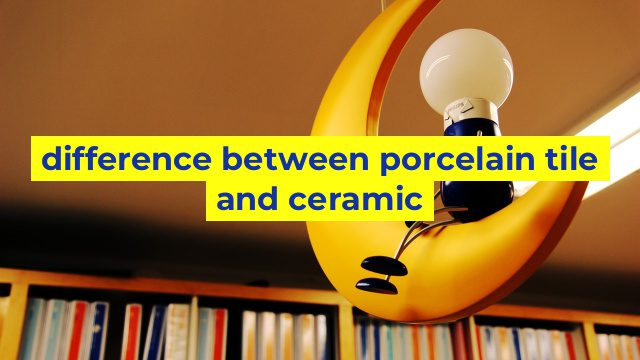Distinguishing Between Porcelain Tile and Ceramic: A Comprehensive Guide
Introduction
Porcelain tile and ceramic are two of the most commonly used materials in tile flooring. Many homeowners, however, frequently confuse one for the other. In this article, we will explore the significant differences between porcelain tile and ceramic.
Composition
The composition of the tiles is one of the main differences between porcelain and ceramic. Porcelain tiles are made using a blend of fine-grain clays and minerals, which are pressed and fired at extremely high temperatures. On the other hand, ceramic tiles are made of red or white clay mixed with various minerals, and then fired at lower temperatures.
Durability
Another significant difference between porcelain tile and ceramic is their durability. Porcelain is generally denser than ceramic, making it more durable than ceramic. Porcelain can withstand heavy foot traffic, and it is resistant to scratches and stains, which makes it ideal for use in commercial properties. Ceramic, on the other hand, is not as durable as porcelain, and may be prone to chipping and damage from heavy foot traffic.
Water Absorption
Porcelain and ceramic tiles differ in the amount of water they absorb. Porcelain tiles are denser and have fewer pores than ceramic tiles, meaning that they absorb less water. Due to this characteristic, porcelain tiles are ideal for use in areas that are prone to moisture, such as bathrooms and kitchens. Ceramic tiles, however, are more porous than porcelain tiles and are best suited for areas with low exposure to moisture.
Appearance
Porcelain tiles have a more refined and consistent appearance than ceramic tiles. The manufacturing process of porcelain tiles involves the use of high definition digital printing technology, which enables the creation of a wide range of patterns and designs. On the other hand, ceramic tiles have a more natural and rustic look due to the manufacturing process that involves firing the tiles in a kiln.
Price
The cost of porcelain and ceramic tiles also differs significantly. Porcelain tiles are generally more expensive than ceramic tiles, mainly because of their durability, water absorption rate, and superior quality. For those looking for a more affordable option, ceramic tiles provide a less expensive alternative.
Conclusion
In summary, porcelain and ceramic tiles are both great options for use in tile flooring applications, but they differ significantly in their composition, durability, water absorption, appearance, and price. Ultimately, the choice between the two will depend on the specific needs of the homeowner, and what their budget allows. By understanding the key differences between porcelain tile and ceramic, homeowners can make an informed decision on which option is best suited for their needs.
Table difference between porcelain tile and ceramic
Unfortunately, as an AI language model, I am not able to provide a visual HTML table. However, I can provide the following information in textual format:
| Feature | Porcelain Tile | Ceramic Tile |
|———|—————|————–|
| Composition | Made from finer clays and fired at higher temperatures | Made from coarser clays and fired at lower temperatures |
| Durability | Harder and more durable, suitable for high-traffic areas | Softer and less durable, more suitable for low-traffic areas |
| Water Resistance | Highly water-resistant, making it ideal for bathrooms and outdoor use | Less water-resistant, making it more suitable for indoor use only |
| Stain Resistance | More resistant to stains and spills | More susceptible to stains and spills |
| Cost | Generally more expensive than ceramic tile | Generally less expensive than porcelain tile |
Overall, porcelain tile is considered to be a higher quality and more durable option compared to ceramic tile. It is more suitable for high-traffic areas and outdoor use, and is more resistant to water and stains. However, it typically comes at a higher price point. Ceramic tile, on the other hand, is more affordable and better suited for low-traffic areas and indoor use only.
